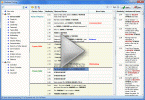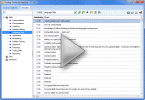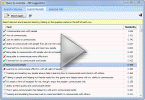Coding and Analyzing Open-Ended Questions
Survey questionnaires typically contain two broad types of questions: open-ended and closed-ended. Closed-ended questions present a discrete set of responses from which to choose. Such types of responses are easily quantified and analyzed while open-ended questions allow the respondent to answer a question in his own words. Such types of unstructured responses often provide richer and more valued information than closed-ended questions and are an important source of insight since they can generate information that was not anticipated. Despite their added value, researchers often prefer to avoid including open-ended questions in their surveys because of the tedious task of reading and coding responses, a time-consuming and expensive task especially when one has more than a few hundred written responses.
The manual coding of verbatim to open-ended questions usually involves the following tasks:
- Reading through all the responses to familiarize oneself with the range of topics mentioned.
- Creating a codebook (which can be done before during the coding process).
- Reading each response and manually applying one or several codes for every text response.
- For achieving a higher quality of coding, survey researchers will often have multiple coders reading and applying codes to the same responses. This allows one to establish clear coding rules and achieve a common understanding of the coding frame. It also allows one to monitor the level of agreement among coders (typically called an inter-coder agreement or inter-coder reliability check).
QDA Miner and WordStat represent efficient alternatives to such time-consuming procedures by offering unique computer assistance for coding and analyzing open-ended responses in a fraction of the time normally required when such a task is performed manually. We will review some of those features and provide some resources to choose the best strategy and to get started. While we focus here on the coding and analysis of open-ended questions from survey data, the same techniques and advice could also be applied for other types of data consisting of a large number of short text responses, such as customer feedback or, Twitter or other social media feeds.
QDA Miner or WordStat?
Both QDA Miner and WordStat offer useful tools for coding and analyzing open-ended questions. The answer to the question about which software to use really depends on a variety of factors, the most obvious one being the number of responses one has to code. Such a decision also depends on other external factors such as the available time and financial resources to code and analyze those responses as well as whether the data comes from a one-time survey or from a recurring survey or an ongoing data-collection process. This decision may also depend on personal preferences or predispositions such as the researcher’s tolerance to coding errors, the social acceptability of computer-automated text analysis, or the perceived human subjectivity in the coding task. As we will see, quite often researchers can benefit from using both tools.
When to use QDA Miner
QDA Miner is essentially a manual coding tool where the final decision whether to apply a code to a specific response remains under the control of a human coder. While QDA Miner offers numerous computer-assistance features that can help achieve faster and more reliable coding, the coder always has the opportunity to review the suggestions before codes are applied. The most basic computer-assistance feature, and the one that people are most familiar with, is the text-search tool that allows retrieval and coding of all responses containing specific keywords or key phrases. QDA Miner provides such a tool, allowing one to use complex search expressions with Boolean operators (AND, OR, NOT) as well as thesaurus-based searches. However, the software goes much further than this by offering advanced search functions relying on information-retrieval techniques such as machine learning, relevance feedback, fuzzy string matching, etc. Here are some of the most useful advanced tools for analyzing transcripts of open-ended questions:
|
|
|
Once the responses have been coded, QDA Miner will offer numerous tools to retrieve all responses associated with a specific code or a combination of codes, compute descriptive statistics and create presentation graphics on those codes (bar charts, pie charts, tag clouds), examine their co-occurrences using cluster analysis, multidimensional scaling or proximity plots, as well as relate codes associated with specific open-ended responses with those from closed-ended questions using tools like crosstabulation, correspondence analysis, heatmaps, bubble charts, etc. QDA Miner also integrates an inter-raters reliability feature to test the level of agreement among coders.
Click here for more information about QDA Miner
When to use WordStat
WordStat provides a very different solution for the coding and analysis of answers to open-ended questions. Rather than relying on human coders, the software offers numerous tools to partly or fully automate the analysis of large amounts of responses or to quickly identify themes and patterns in text data without the necessity of reading individual responses. WordStat is especially appropriate when analyzing a very large number of open-ended responses (from several hundred to tens or hundreds of thousands of responses), or when one wants to develop a coding solution that may later be reapplied to similar text responses. While a manual revision is still possible, such a revision typically occurs after the text data has been coded or classified. WordStat offers three broad types of strategies to analyze responses to open-ended questions:
-
- TEXT MINING – One can adopt an exploratory approach to text data by applying a combination of NLP (natural language processing) techniques and statistical methods. For example, by analyzing the co-occurrence of the most common words or phrases using a Hierarchical Clustering technique, one can easily identify the most common topics mentioned in the survey. The Proximity Plot may then be used to show words or phrases that are most often associated with a specific topic, brand, person, or company name and to quickly compare those with the ones associated with another target name or topic. Correspondence Analysis may also be used to identify patterns of words and phrases that are specific to different groups of respondents or to see how those are related to scores measured using other closed-ended questions. All these exploratory techniques can produce insightful results from a large collection of textual data in a matter of seconds.
- CONTENT ANALYSIS – WordStat also offers state-of-the-art content analysis tools that may be used to build and apply categorization dictionaries (what others may call “taxonomies”). The main idea behind this approach is to measure references to specific concepts or themes by identifying the various ways one could express such ideas. A content-analysis dictionary can consist of a large number of categories, where each category may itself contain hundreds of words, word patterns, phrases, and rules. One can apply existing content-analysis dictionaries developed by others (see a list of existing dictionaries) or create one’s own dictionary. While developing and validating a dictionary does require some time, when analyzing large data sets consisting of a thousand or more open-ended responses, such an approach will typically be faster than manually coding individual responses. Furthermore, once developed, a content-analysis dictionary can be applied to new data sets consisting of responses to similar questions and can produce results in a matter of seconds. Such an approach is thus ideal if one needs to partly automate the coding of text responses from recurring surveys or for analyzing ongoing text-data collections such as text from social-media or customer-feedback systems.
.


- AUTOMATIC DOCUMENT CLASSIFICATION – A third approach consists of coding open-ended responses by applying supervised machine-learning techniques to automatically classify responses into one or several categories. Such an approach requires the availability of a relatively large amount of responses already coded. The codings of those responses are used as learning examples by which the software will attempt to automatically identify similar examples of those in uncoded responses using keywords or phrases. WordStat offers a choice between two popular machine-learning algorithms: Naive Bayes and k-Nearest Neighbors. The automatic classification technique may be used to generate dichotomous decisions (present or absent), a nominal classification (one out of “n” mutually exclusive values) or to generate a score on an ordinal scale (such as a Likert scale).
- TEXT MINING – One can adopt an exploratory approach to text data by applying a combination of NLP (natural language processing) techniques and statistical methods. For example, by analyzing the co-occurrence of the most common words or phrases using a Hierarchical Clustering technique, one can easily identify the most common topics mentioned in the survey. The Proximity Plot may then be used to show words or phrases that are most often associated with a specific topic, brand, person, or company name and to quickly compare those with the ones associated with another target name or topic. Correspondence Analysis may also be used to identify patterns of words and phrases that are specific to different groups of respondents or to see how those are related to scores measured using other closed-ended questions. All these exploratory techniques can produce insightful results from a large collection of textual data in a matter of seconds.
Note: A WordStat software-development kit (SDK) is also available separately for those who wish to fully automate the text-analysis process using either a content-analysis approach or an automatic document-classification approach and integrate such a feature into their data-collection process.
While each of the above techniques may be used separately, one will often profit from combining these. For example, hierarchical clustering of the most frequent words may be used to identify the most common topics as well as an organizing structure of those topics. Such a structure may then be replicated in a content-analysis dictionary by the creation of specific content categories to measure those themes and by grouping those specific categories into broader content categories. A correspondence analysis of words may also be used to identify hypotheses that may later be tested by the development of more comprehensive dictionaries. One may also use a content-analysis dictionary to confine the automatic document classification to specific keywords or to make sure close synonyms, inflected or misspelled forms of words will not be ignored or be treated independently from each other.
Click here for more information about WordStat
Why using both QDA Miner and WordStat
There are many ways one can combine the computer-assisted qualitative coding features of QDA Miner with the content-analysis and text-mining tools available in WordStat. Even those who rely entirely on manual coding will find WordStat exploratory text analysis features useful for familiarizing themselves with the range of topics being mentioned and to identify not only potential codes but also a codebook structure that will be appropriate for organizing all those codes. WordStat content analysis or automatic document classification features may also be useful to select a limited set of potentially more relevant responses from a huge amount of text responses (too large to be coded manually). These more relevant responses may then be examined more carefully by human coders.
Those researchers relying instead on WordStat for automatically quantifying text responses will often feel the need to review the obtained results and to make manual adjustments to some of those results in order to achieve greater precision. They may also find some topics quite difficult to identify automatically and may thus need to go back to a more manual approach of coding. Finally, the development of an automatic document classification model requires the availability of a training set of responses carefully categorized by human coders. If such a training set is not available, the researcher will have no choice but to create one. QDA Miner computer-assistance features could be very useful for quickly coding and validating such a training set.
Those are just a few examples of benefits one can achieve in combining a human-coding approach with computer-assisted and computer-automated approaches to the task of coding responses to open-ended questions. The close integration of QDA Miner and WordStat allows for such combinations. WordStat categorization dictionaries and automatic document classification models may be stored on disk, culled from within QDA Miner, then applied either for text retrieval or autocoding of text responses. Qualitative coding performed in QDA Miner may also be used to control what WordStat will analyze. These are just a few examples of how one can combine these two text-analysis software systems.
Some resources
This section offers some available resources to help you learn a little bit more about the use of QDA Miner and WordStat for analyzing open-ended questions from surveys or from customer-feedback questionnaires.
- This flash tutorial will show you how to import survey data from an Excel spreadsheet into QDA Miner and how to perform basic data preparation (click here).
- This 46-page document from the CAQDAS Networking Project at the University of Surrey provides step-by-step guidance for preparing texts from open-ended questions, for analyzing qualitative and quantitative data in QDA Miner and for exporting the results to statistical software (click here).
- There are several short video demos of specific features of QDA Miner and WordStat that are especially useful for the analysis of short text responses. Here is a list of those that we believe could be the most useful for such types of data.
- QDA Miner – Cluster Retrieval
- QDA Miner – Code Similarity Retrieval
- QDA Miner – Query by Example
- QDA Miner – Creating bar charts and bubble charts
- QDA Miner – Frequency and crosstab of numerical and categorical data
- QDA Miner – Using the report manager
- WordStat – General Introduction to WordStat features
- WordStat – Drag-and-drop editing of dictionaries
- WordStat – Identifying synonyms and related words
- WordStat – Exporting data to other software
Additional video demos of features are also available from the Tutorials page.
Some surveys that used QDA Miner or WordStat
The following list shows studies from researchers who have used QDA Miner, WordStat or both for analyzing responses to open-ended questions. The size of these surveys varies a lot – from a small sample of 104 environmental scientists (Wright & Wyatt, 2008) to a much bigger survey of more than 41,500 federal government employees (U.S. Merit Systems Protection Board, 2011).
Behruzi, R., Hatem, M., Goulet, L., Fraser, W. (2011). The facilitating factors and barriers encountered in the adoption of a humanized birth care approach in a highly specialized university affiliated hospital. BMC Women’s Health, 11(1):53 (2011) PMID 22114870.
DeCarlo, K.A, Pierskalla, C.D., Selin, S.W., & Siniscalchi, J.M. (2005). Interpretative theme development from first impressions and visitor center evaluations at the Spruce Knob‑Senaca Rocks National Recreation Area, WV. Proceeding of the 2005 Northeastern Recreation Research Symposium. 177‑185. Bolton Landing, NY.
Frank, B.A. & Walsh, R.J. (2011). Does reflective learning take place in online MBA introductory quantitative courses? Journal of Instructional Pedagogies.
Harper, C.A., Shaw, C.E, Fly, J.M., & Beaver, J.T. (2012). Attitudes and motivations of Tennesse deer hunter toward quality deer management. Wildlife Society Bulletin. Published Online, May 3rd, 2012.
Latham, S. (2009). Contrasting strategic response to economic recession in start-up versus established software firms. Journal of Small Business Management, 47(2), 180-201.
McComas, K.A., Besley, J.C., & Trumbo, C.W. (2007). Why citizens do and do not attend public meetings about local cancer cluster investigations. Policy Studies Journal, 34(4), 671-698.
Pullman, M. McGuire,K, Cleveland, C. (2005). Let me count the words: Quantifying open‑ended interactions with guests. Cornell Hotel and Restaurant Administration Quarterly, 46(3), 323‑343.
Saunders, M.N.K. (October, 2011). Web versus mail: The influence of survey distribution mode on employees’ response. Field Methods. Online. October 9, 2011.
Schmitz, D. & Raymond, K. (2011). Ensuring Access to 21st Century Learning Project: Report to the Colorado Department of Education. Poudre School District: Fort Collins, CO.
Spinks, N., Silburn, N., & Birchall, D. (2006). Educating engineers for the 21sth century: The industry view. Henly Management College: Henley‑on‑Thames: UK.
U.S. Merit Systems Protection Board (2011). Making the Right Connections: Targeting the Best Competencies for Training. Washington, D.C.
Wright, T.S.A, & Wyatt, S.L (2008). Examining influences on environmental concern and career choice among a cohort of environmental scientists. Applied Environmental Education and Communication, 7, 30-39.










